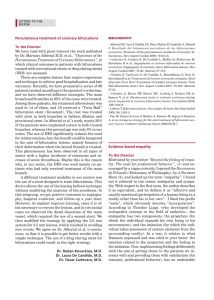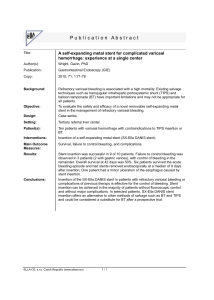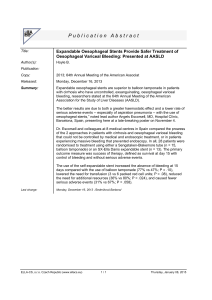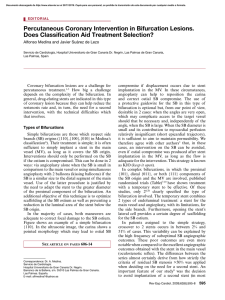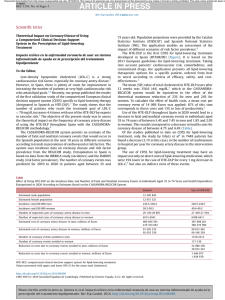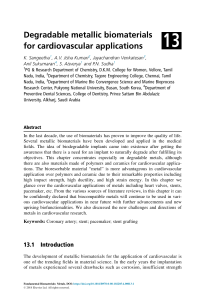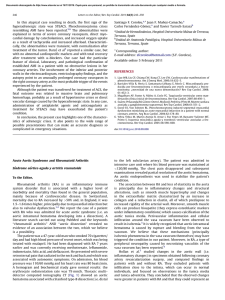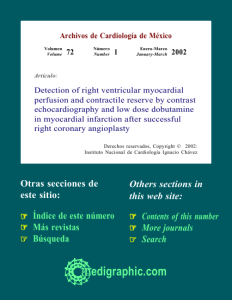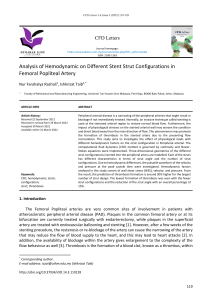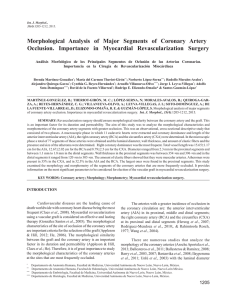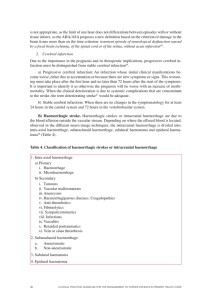Obstrução aguda do tronco da artéria coronária esquerda com
Anuncio
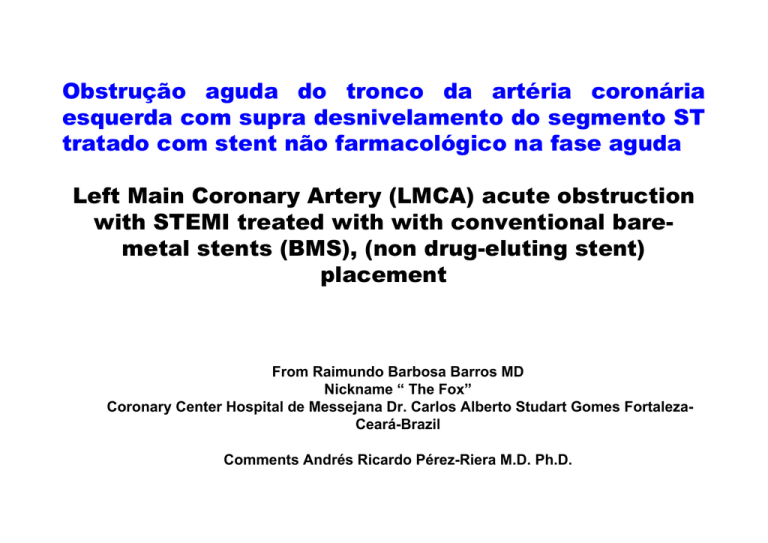
Obstrução aguda do tronco da artéria coronária esquerda com supra desnivelamento do segmento ST tratado com stent não farmacológico na fase aguda Left Main Coronary Artery (LMCA) acute obstruction with STEMI treated with with conventional baremetal stents (BMS), (non drug-eluting stent) placement From Raimundo Barbosa Barros MD Nickname “ The Fox” Coronary Center Hospital de Messejana Dr. Carlos Alberto Studart Gomes FortalezaCeará-Brazil Comments Andrés Ricardo Pérez-Riera M.D. Ph.D. Hello, Prof. Andres, When you return from your well-deserved holidays with your family, let's present this case, in which the patient survived, to the forum. Male, 54-year-old patient, admitted with chest pain and BP=70/40 mmHg and signs of low output. The initial ECG showed evident signs of acute left main coronary artery (LMCA) obstruction. He underwent a successful angioplasty with non drug-eluting stent placement (conventional bare-metal stents (BMS), conventional stent or non-pharmacological) in the LMCA with reversion of hemodynamic instability symptoms. Additionally, 2b3a was used, besides anti-platelet aggregation drugs (aspirin+clopidogrel). Watch the RBBB disappearing. Echo was performed 8 days after admittance, showing LVEF=56%. I am also sending the control left heart catheterization carried out 1 week later. We know that pharmacological stents or drug-eluting stents (DES), when implanted in the LMCA in the acute phase of AMI with ST elevation, shows a satisfactory evolution. Question: taking into account that the implanted stent was non drug-eluting stent, is there indication of additional revascularization surgery? Or only in the case of signs of spontaneous ischemia, or during functional test? Currently, he is in the ward, clinico-hemodynamically stable. Warm regards, Raimundo Barbosa Barros M.D. Paciente masculino de 54 anos admitido com cor dor torácica e PA=70/40 mmHg e sinais de baixo débito. O ECG inicial mostra sinais evidentes de obstrução aguda do tronco da artéria coronária esquerda. Foi submetido com sucesso à angioplastia com stent convencional(não farmacológico) no tronco da artéria coronária esquerda com reversão do quadro de instabilidade hemodinâmica. Adicionalmente foi utilizado 2b3a além da dupla antiagregação plaquetária (aspirina + clopidogrel). Observe o desaparecimento do BRD do segundo traçado. O Ecocardiograma realizado 8 dias após a admissão mostra FE=56%. Estou enviando também o Cateterismo de controle realizado uma semana após. *Sabemos que o stent farmacológico quando implantado no tronco da artéria coronária esquerda na fase aguda do IAM com supra apresenta evolução satisfatória. Questionamento: tendo em vista que o stent implantado não foi farmacológico, haveria indicação de revascularização cirúrgica adicional?ou só se houver sinais de isquemia espontânea ou durante teste funcional? Atualmente encontra-se na enfermaria com quadro clínico-hemodinámico estável. Um abraço Raimundo Acute occlusion of the Left Main Coronary Artery presenting as ST segment elevation myocardial infarction (STEMI) complicated with RBBB Admissão December 27-2011 In LMCA occlusion the ST injury vector pointing upward and rightward to aVR lead. In the present case it is directed to aVL (atypical) Th eS Ti nju ry vec tor aV R Absence of ST segment elevation in aVR. In acute LMCA obstruction, death occurred more frequently in patients with higher ST segment elevation in lead aVR than in those with less severe elevation.(1) This patient had a favorable evolution. Subepicardial injury current L aV X I LV 1. III Y II Yamaji H, Iwasaki K, Kusachi S, et al, Prediction of acute left main coronary artery obstruction by 12lead electrocardiography. ST segment elevation in lead aVR with less ST segment elevation in lead V(1). J Am Coll Cardiol. 2001 Nov 1;38:1348-1354. aVF ST segment depression in inferior leads. ST depression III> II (Atypical) Complete RBBB complicated with anterior myocardial Infarction: QR pattern in right precordial leads Z X LV V6 V5 V4 V1 V3 V2 V1 1. 2. 3. 4. 5. 6. 7. ST Segment elevation =2.mm Symmetric negative T wave with broad base: subepicardial ischemia (T wave in “seagull”). qR pattern, QRS duration 162ms THE POSSIBLE CAUSES OF qR PATTERN IN V1 Severe right ventricular hypertrophy(1) (Supra-systemic Intraventricular pressure inside RV) Right Atrial Enlargement: qR pattern in V1 may be an indirect sign of RAE Complete RBBB complicated with anterior myocardial Infarction2;3. Ebstein's anomaly: bizarre and low voltage RBBB with initial q wave 4. Congenitally Corrected Transposition: Secondary to inversion of septal activation, RAE, by progressive tricuspid regurgitation that occurs with age and associated with deterioration of RV function5;6 Situs inversus: ventricular inversion: Because inverted septal activation. Congenitally Corrected Transposition: Secondary to inversion of septal activation, RAE, by progressive tricuspid regurgitation that occurs with age and associated with deterioration of RV function(5;6) 8. Endomiocardiofibrosis7 9. Anterior MI or ischemia / injury associated with LSFB. S-T elevation and increase in R-wave 9. voltage “giant R waves” also displayed concomitant shift of the frontal QRS axis toward the locus of injury(8;9;10;11;12;13.). 10. Pectus excavatum References 1. 2. 3. 4. 5. 6. 7. 8. 9. 10. 11. 12. 13. Gandhi MJ, Dattey KK, Kulkarni TP, Hansoti RC. Genesis of qR pattern in right precordial leads in right ventricular overload. J Assoc Physicians India. 1962; 10: 217-223. Sodi-Pallares D, Bisteni A, Herrmann GR. Some views on the significance of qR and QR type complexes in right precordial leads in the absence of myocardial infarction. Am Heart J. 1952 May;43(5):716-34. Rudiakov LaI. On The Diagnostic Significance Of The qR Type QRS Complex In Right Electrocardiographic Leads. Kardiologiia. 1964; 18: 72-73. Kumar AE, Fyler DC, Miettinen OS, Nadas AS. Ebstein's anomaly. Clinical profile and natural history. Am J Cardiol. 1971; 28: 84-95. Warnes CA. Transposition of the great arteries. Circulation 2006; 114: 2699-2709. Ruttenberg HD, Elliott LP, Anderson RC, Adams P Jr, Tuna N. Congenital corrected transposition of the great vessels. Correlation of electrocardiograms and vector cardiograms with associated cardiac malformations and hemodynamic states. Am J Cardiol. 1966; 17: 339-354. Tobias NM, Moffa PJ, Pastore CA, et al. The electrocardiogram in endomyocardial fibrosis Arq Bras Cardiol. 1992; 59: 249-253. David D, Naito M, Michelson E, et al. Intramyocardial conduction: a major determinant of R wave amplitude during acute myocardial ischemia. Circulation 1982; 65:161-166. Deanfield JE, Davies G, Mongiardi F, et al. Factors influencing R wave amplitude in patients with ischemic heart disease. Br Hear J 1983; 49:8-12. Schick EC Jr, Weiner DA, Hood WB Jr, et al. Increase in R-wave amplitude during transient epicardial injury (Prinzmetal type). J Electrocardiol. 1980;13:259-266. Feldman T, Chua KG, Childers RW. R wave of the surface and intracoronary electrogram during acute coronary arterial occlusion. Am J Cardiol 1986; 58: 885-900. Hassapoyannes CA, Nelson WP. Myocardial ischemia-induced transient anterior conduction delay. Am Heart J 1991; 67:659-660. Madias JE. The “giant R waves” ECG pattern of hyperacute phase of myocardial infarction. J Electrocardiol 1993;26:77-80. VAT = 135ms! In non-complicated CRBBB R-peak time ≥50ms in lead V1 and normal in V5-V6 VAT Na+ Na+ 0 0 B A VAT or R-peak time: ventricular activation time or “R-peak time” very prolonged A: Norman action potential. B: Ischemic action potential. CURRENT MODEL OF VENTRICULAR SEGMENTATION AND WALL/ARTERY IRRIGATION Ao RV 7 LA LV 15 Apical four chambers RV RA Bulls eye (short axis) Anterior Wall 4 10 LV LA 1 Longitudinal paraesternal axis Septal Wall 13 17 LV 15 Lateral Wall Inferior Wall Left Anterior Descending (LAD) LMCA + Left Circunflex (LCx) Posterior Descending (RCA or LCx) 4 10 Apical two chambers LV LA CLASSICAL LMCA OCCLUSION ECG CRITERIA • • • • • • • ST segment elevation in aVR, and V1 ST segment elevation in aVR > V1 Ischemic evidences in inferobasal* wall: depression of the ST segment in II and from V4 to V5 ST segment depression in II or in inferior leads II>III Depression of ST segment in V6 > ST segment elevation in V1 Diffuse ST segment depression in the inferolateral leads Eventually observation of RBBB, LAFB and/or LSFB. 4 15 10 4 ECG preformed 9 days later (January 05, 2012) It is evident the disappearance of the RBBB Septal MI (QS in V1-V2.) High lateral infarction (q aVL) ST segment depression in inferior leads Lack of a septal q in V5-V6 Admission Coronariography LMCA oclussion Dominant RCA Stent in LMCA CD2 LMCA occlusion = A3 + B1 EXTENSIVE ANTERIOR INFARCTION Extensive anterior myocardial infarction Type: A-3 Most likely site of occlusion: proximal LAD ECG pattern: Q from V1 through V6, I and VL Segments compromised by infarction CE-CMR: image in the next slide SE: 83% SP: 100%. LATERAL INFARCTION Lateral Type: B-1 Most likely site of occlusion: LCx artery or its oblique marginal branch (OM) ECG pattern: RS in V1-V2 and/or Q in I, VL, V5-V6. Voltage of R wave in V6 of less amplitude Segments compromised by infarction in CE-CMR: image in the next slide. SE: 67% SP: 99%. EXTENSIVE ANTERIOR INFARCTION A-3 ANTERIOR WALL L A T E R A L S E P T A L W A L L W A L L INFERIOR WALL ECG pattern: Q from V1 through V6, VL, possibly I and VL LATERAL INFARCTION B-1 ANTERIOR WALL L A T E R A L S E P T A L W A L L Cx W A L L INFERIOR WALL ECG pattern: RS in V1-V2 and/or Q in I, VL, V5-V6. Voltage of R in V6 of less amplitude LMCA OCLUSION . V1 TO V6 + I AND aVL. EXTENSIVE ANTERIOR INFARCTION+ High lateral NORMAL aVL Extensive anterior + lateral: V1 to V6 + I and aVL. HL HS MS LS A V6 aVL V1 V2 I V3 V6 V1 HL: high lateral A: apical HS: high septum MS: middle septum LS: low septum V2 V5 V3 V4 Area involved in the ventricular cone in case of LMCA occlusion. It involves the septum (high, middle, and low), the apical region and the high lateral free wall. Significant Q wave from V1 to V6 and I and aVL. Coronariografy performed one week after non-drug-eluting stent implantation showing good patency of LMCA Colleagues opinions Andres, Dr. Barbosa and his colleagues should be congratulated on their management of this patient. The fact that he survived at all is a miracle but even more impressive is the degree of preserved ventricular function even though the second 12 lead ECG does show evidence of a septal (QS in V1-2, lack of a septal q in V5-6) and possibly high lateral infarction (q aVL, rS in Lead I). The follow-up cardiac catheterization one week after stent placement does not show a specific lesion that requires bypass surgery at this time. The very dominant right coronary artery demonstrated on the initial cardiac catheterization does not show any high grade lesion warranting bypass surgery or stent placement at this time, at least in the views provided. I would continue double antiplatelet therapy (ASA and clopidogrel) at this time, plan on an exercise tolerance test in 1 to 2 months allowing him to recover from this acute nearly catastrophic event and follow him clinically. If he was not already on a statin, I would start that (after checking his serum lipids) and consider also placing him on a beta blocker. If he is a smoker – he should be counseled to stop. If he has high blood pressure and/or diabetes mellitus, those should be treated aggressively. If he has a positive family history – well, it is too late to do anything about that. In that the male gender is a risk factor for CAD, as I counsel my patients, there is nothing that we can do about that either. Paul Paul A. Levine MD, FHRS, FACC, CCDS 25876 The Old Road #14 Stevenson Ranch, CA 91381 Cell: 661 565-5589 Fax: 661 253-2144 Email: [email protected] Dear Raimundo and Andrés - again a nice case. Anterior STEMI with RBBB and left axis is one of the patterns described in case reports and small series of acute total occlusion of the left main. In this patient, angiography shows thrombotic occlusion of the left main and the result with stenting is excellent. Bypass surgery is not an option at this point, because there are no significant stenoses in the coronary arteries. Bypass grafts tend to occlude if placed into coronaries with excellent flow. In my opinion, bare metal stent is not a bad option in this case. I agree with the following conclusions from a recent paper: Hironori Kaneko, MD; Mikihiro Kijima, MD. (Circ J 2011; 75: 1243 – 1249). "According to many reports on a comparison between DES and BMS for treatment of unprotected left main disease, the outcomes of DES are superior. However, those in a further remote phase are unknown. Given unsolved problems of late catch-up phenomenon, late stent thrombosis, etc., selection of BMS should also be considered for relatively young patients, those in whom long-term administration of antiplatelet agents is difficult, and especially those with ostial/midshaft lesions of the LMCA with a large diameter." There is a risk for restenosis and some invasive centers tend to perform a control angiography within 6-9 months. Other interventionists rely on patient symptoms and/or an exercise test. Kindly Kjell Nikus, Tampere, Finland Estimado Andrés y Raimundo - de nuevo un buen caso. STEMI anterior con el eje de bloqueo de rama derecha y la izquierda es uno de los patrones descritos en informes de casos y series pequeñas de la oclusión aguda total del tronco de la coronaria izquierda. En este paciente, la angiografía muestra la oclusión trombótica del tronco de la coronaria izquierda y el resultado de la colocación del stent es excelente. La cirugía de revascularización no es una opción en este momento, porque no hay estenosis significativa en las arterias coronarias. Injertos tienden a ocluir si se coloca en las coronarias, con excelente flujo. En mi opinión, stent de metal no farmacológico(BMS) no es una mala opción en este caso. Estoy de acuerdo con las siguientes conclusiones de un reciente artículo: Hironori Kaneko, MD; Mikihiro Kijima, MD. (Circ J 2011; 75: 1243 a 1249). "De acuerdo con numerosos informes sobre la comparación entre el stent farmacológico(DES) y el BMS para el tratamiento de la enfermedad de tronco no protegido, los resultados de las DES son superiores. Sin embargo, la evolución en una fase más tardias son desconocidos. Teniendo en cuenta los problemas no resueltos del fenómeno de finales de catch-up, tardía del stent trombosis, etc, la selección de BMS también debe ser considerada en pacientes relativamente jóvenes, aquellos en los que a largo plazo la administración de antiagregantes plaquetarios es difícil, y especialmente aquellos con lesiones ostiales / diáfisis del tronco con un diámetro grande.“ Existe un riesgo de reestenosis y algunos centros invasivo tienden a realizar una angiografía de control dentro de 6-9 meses. Otros se guian por los síntomas del paciente y / o una prueba de esfuerzo. Amablemente Kjell Nikus, Tampere, Finlandia Queridos amigos voy a tratar de analizar el caso extraordinario mandado por el Dr Raimundo Barros Barbosa,y el Profesor Andres Ricardo Perez Riera MD PhD Tratare de analizar el ECG de entrada al sitema hospitalario ,sin tener en cuenta el resultado de la coronariografia En el ECG 27/12 /011 la frecuencia cardiaca 160 por min , Cosa muy rara en obstrucciones subita de cualquier arteria ( y ya lo discutimos de la importancia de los receptores adenosiicospendient de Acetilcolina y ATP dependiente) La elevacion del ST en V1 . V2 .V3 ,aVLy en DI ,pero con onda T inverida y sin participacion de la punta cardiaca y la cara lateral ,es decir indica el borde e la isquemia Es decir hay una cierta proteccion El bloqueo derecho, no parece ser isquemico , ya que en las isquemias agudas los BD ,(bloqueos por isquemia) va acompañado por hemibloqueo anterosuperior No sera un bloqueo por taquicardia? Entonces el ecg lo obliga a mira mejor la coronariografia , yse ve en la derecha y superior las imagenes muy tenue de la anterior descendente , y de la Cx Esto es lo que le dice las ondas T invertidas en las precordiales derechas ( que ya hay reperfusion miocardica leve incompleta), y la falta de participasion dfe los complejos izquierdos La taquicardia se podra explicar por la administracion de nitratos y de la bajada de la presion arterial La arteria derecha dominante tambien proporciono un poco de proteccion el ECG de 9 dias mas tarde muestra que la arteria ant desc esta obstruida o el miocardio irrigada por la AD esta , sin circulasion Observece que el ST -T esta elevado en DI y aVL ,con descenso de la ST-T en DII,DII y AVF ,sugeriendo que la obstruccion completa esta por encima de la diagonal primera,y la elevacion del ST-T enV2 ,V3, sin alteracion de las derivaciones laterakes izquierdas. Mi conclusion era que la arteria izquierda central estaba colapsada ( esta arteria no tiene autoregulsacion , y al bajar la presion se colapsa) y este no era el problema , sino la ant descente que sigue obstruida Recomiendo hacer otro eco ,me parece que hay una severa disqinesia septal , con LVEF%, MENOS DE 40 Espero que no me manden al m....a , por intrometido , aguafiesta Pero es importante acentuar el significado del electro en entender los fenomenos hemodinamicos isquemicos y la electrofisiologia de los procesos isquemicos y como asi tambien entender la anatomia coronaria a travez de los signos ecg en las isquemias agudasd Un fraternal abrazo a todos los foristas y la discusion esta abierta en este caso apasionante Samuel Sclarovsky Estimados amigos del foro. Mi opinion del caso presentado: 1. Claramente el primer ECG corresponde a obstrucción de tronco (con supra ST en avR y V1 con un "signo tombsting“ asociado a bloqueo de rama derecha por isquemia de las 4 porciones de la rama derecha al estar comprometidas las perforantes septales 2. En el segundo ECG, pos revascularización mecánica (stent metálico) desaparece el bloqueo de rama derecha y los signos de lesión. 3. En relación a la conducta a ser tomada lo ideal huviera sido la colocación de un stent con liberación de drogas, porque en estos la tasa de reestenosis es menor que el metálico (promedio 4% vs 30 %) tratandose de vasos de calibre mediano. El tronco, por ser un vaso de mayor calibre y mayor flujo la tasa promedio de reestenosis del stent metálico es de menor del 10%. Además es recomendable prolongar el uso de clopidogrel mas de 6 meses, hacer control clinico cercano de isquemia y nuevo cateterismo a los 6 meses. Saludos cordiales Juan Sirena Dear friends from forum My opinion related to this case The first ECG clearly corresponds to obstruction of LMCA with ST segment elevation myocardial infarction (STEMI) in aVR and V1 and “tombostoning” sign associated with complete right bundle branch block (CRBBB), consequence of ischemia of the fourt portions of the right bundle branch being compromised septal perforator.The second ECG, preformed after implantation of conventional bare-metal stent (BMS), disappears CRBBB and lesion signs. Related to the conduct ideally a placement of drug-eluting stent is the best option, because the rate of restenosis is lesser. In vessel with medium caliber (restenosis average 4% vs 30%). The LMCA, being a vessel of larger caliber and higher average flow rate the stent restenosis is less than 10%. In addition it is recommended to extend the use of clopidogrel more than 6 months, close clinical monitoring of ischemia and new catheterization at 6 months. Best Regards. Juan Sirena M.D. New nickname John Bell Final comments Fox & Potro Raimundo Barbosa-Barros Andrés Ricardo Pérez-Riera Left main coronary artery (LMCA) occlusion is a rare occurrence that is often fatal. It usually manifests as an AMI with cardiogenic shock and/or fatal arrhythmias since occlusion of this vessel compromises flow to at least 75 % of the LV, unless it is protected by collateral flow or a patent bypass graft to either the LAD or LCX. Studies performed before revascularization with Coronary Artery Bypass Graft surgery (CABG) became the standard of care revealed a poor prognosis for these patients, with three-year survival as low as 37% . Significant, defined as a greater than 50% narrowing, LMCA disease (LMCAD) is found in 4 to 6% of all patients who undergo coronary arteriography(1). When present, it is associated with multivessel coronary artery disease about 70% of the time(2;3). Most patients are symptomatic and at high risk of cardiovascular events. CABG, when directly compared to medical therapy, is associated with significantly better cardiovascular outcomes, including mortality(4). Percutaneous coronary intervention (PCI) with stenting has generally been restricted to such patients considered inoperable or at high risk for CABG, or with prior CABG and at least one patent graft to the LAD or LCX (so-called "protected" LMCA disease). Graft patency is important in this setting in the event of acute or late closure after PCI. However, evidence is increasing to support the use of PCI with stenting in some cases. Asymptomatic patients with LMCA lesions felt to not be hemodynamically significant should be managed with preventative therapies. Patients with anginal symptoms attributable to lesions elsewhere should be managed with therapies similar to those used in other patients with coronary artery disease. 1. 2. 3. 4. Ragosta M, Dee S, Sarembock IJ, et al. Prevalence of unfavorable angiographic characteristics for percutaneous intervention in patients with unprotected left main coronary artery disease. Catheter Cardiovasc Interv. 2006;68(3):357. Taggart DP, Kaul S, Boden WE, et al. Revascularization for unprotected left main stem coronary artery stenosis stenting or surgery.J Am Coll Cardiol. 2008;51(9):885. Serruys PW, Morice MC, Kappetein AP, SYNTAX InvestigatorsPercutaneous coronary intervention versus coronaryartery bypass grafting for severe coronary artery disease.N Engl J Med. 2009;360(10):961. Eagle KA, Guyton RA, Davidoff R, et al, American College of Cardiology, American Heart AssociationACC/AHA 2004 guideline update for coronary artery bypass graft surgery: a report of the American College of Cardiology/American Heart Association Task Force on Practice Guidelines (Committee to Update the 1999 Guidelines for Coronary Artery Bypass Graft Surgery).Circulation. 2004;110(14):e340. The use of intracoronary stents in PCI has resulted in significant reductions in acute vessel closure and restenosis. As a result, intracoronary stents have replaced stand-alone balloon angioplasty for almost all coronary lesions. However, bare metal coronary stents still undergo angiographic and clinical in-stent restenosis in 20 to 30 % and 10 to 15% of patients, respectively (1;2). Drug-eluting stents have dramatically reduced in-stent restenosis, but current generations have been demonstrated to have increased risk for late thrombosis and require longer term dual anti-platelet therapy. Modifications to stent design are frequently introduced to overcome one or more of the limitations of currently available stents. Some of these represent prototypes in the process of development of the next major advance, while others have limited usefulness due to recognition of limitations after general use. STENTS NOT IN CURRENT USE Heparin-coated stents — Metallic endoprostheses carry a clear risk of local clotting until they are covered by a functioning endothelium. The early 3 to 5% rate of subacute (0 to 30 day) stent thrombosis, however, has been significantly reduced (to less than 1%) by changes in the anticoagulation regimen, which now includes aspirin and a thienopyridine derivative (ticlopidine or most often clopidogrel). However, numerous modifications have been undertaken to render stents intrinsically less thrombogenic. One such approach was the development of heparin-coated stents (3:4). These devices demonstrated benefit over PTCA in the randomized BENESTENT II trial (3) for combined clinical end points (death, myocardial infarction (MI), or reintervention) (12.8 % versus 19.3% in the PTCA group) and of angiographic restenosis rate (16%versus 31 %). 1. 2. 3. 4. Fischman DL, Leon MB, Baim DS, et al.A randomized comparison of coronary-stent placement and balloon angioplasty in the treatment of coronary artery disease. Stent Restenosis Study Investigators.N Engl J Med. 1994;331(8):496. Cutlip DE, Chauhan MS, Baim DS, et al. Clinical restenosis after coronary stenting: perspectives from multicenter clinical trials. J Am Coll Cardiol. 2002;40(12):2082. Serruys PW, van Hout B, Bonnier H, et al.Randomised comparison of implantation of heparin-coated stents with balloon angioplasty in selected patients with coronary artery disease (Benestent II)Lancet. 1998;352(9129):673. Lev EI, Assali AR, Teplisky I, et al. Comparison of outcomes up to six months of Heparin-Coated with noncoated stents after percutaneous coronaryintervention for acute myocardial infarction.Am J Cardiol. 2004;93(6):741. In recent manuscript Dr Kaneko et al wrote textually(1): “due to the advent of drug-eluting stents (DES), restenosis rates have decreased in comparison to conventional bare-metal stents (BMS), and the range of applications of percutaneous coronary intervention (PCI) for unprotected left main coronary artery disease has been expanded. However, even if drug-eluting stents is used, outcomes of PCI for distal left main coronary artery bifurcation lesions are not sufficient. Moreover, problems specific to drug-eluting stents, such as late stent thrombosis and late catchup phenomenon, have been identified. There are still unknown points regarding remote-stage outcomes of drug-eluting stents. Thus, further investigation is needed on PCI for unprotected left main coronary artery disease, along with further analysis of remote-stage outcomes of BMS”. As Dr Nikus wrote before, in patients with thrombotic occlusion of the LMCA the result with stenting are excellent. It is not necessary revascularization. Only the antiplaquetary drugs by a long time.( minimum 1 year) Among STEMI patients undergoing primary angioplasty, both sirolimus-eluting stents (SES) and paclitaxel-eluting stents (PES) are associated with significant benefits in terms of target lesion revascularization at the long-term follow-up compared with bare metal stents (BMS) with no excess risk of thrombotic complications. Thus, until the results of further large randomized trials with long-term follow-up become available, drug-eluting stents may be considered among STEMI patients undergoing primary angioplasty.(2) 1. 2. Kaneko H, Kijima M. Role of bare-metal stents for left main coronary artery disease in the era of drug-eluting stents. Which coronary stent should be used for left main trunk disease? BMS or DES? (BMS-side)-. Circ J. 2011;75:12431249. Di Lorenzo E, Sauro R, Varricchio A, et al. Long-Term outcome of drug-eluting stents compared with bare metal stents in ST-segment elevation myocardial infarction: results of the paclitaxel- or sirolimus-eluting stent versus bare metal stent in Primary Angioplasty (PASEO) Randomized Trial. Circulation. 2009 Sep 15;120:964-972. EXAMPLES OF LMCA OCLUSION Acute LMCA occlusion example: Atrial fibrillation with high HR rate, left anterior fascicular block (LAFB), significant ST segment elevation in aVR (STEMI aVR>V1) ST segment depression in II, minimal ST segment elevation in V1, ST segment depression from V4 to V6.(see the next two slides) LMCA occlusion example in 47 yo man. ST segment elevation myocardial infarction (STEMI) complicated with RBBB + LAFB
